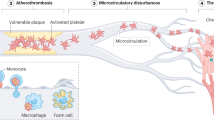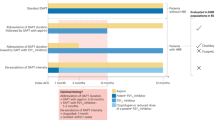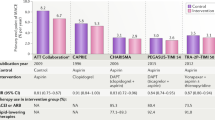Abstract
Dual antiplatelet therapy with clopidogrel and aspirin is recommended for the prevention of ischemic events in high-risk patients with coronary artery disease. In patients with atrial fibrillation, oral anticoagulant therapy with warfarin is the 'gold standard' for the prevention of thromboembolism. Nearly 20% of patients with atrial fibrillation also have coronary artery disease and receive combination therapy consisting of dual antiplatelet therapy plus warfarin, also known as triple antithrombotic therapy. Unfortunately, though, increased bleeding risk is a major concern during triple therapy. Whether platelet function testing can guide personalized antiplatelet therapy and reduce ischemic risk is under investigation in large trials of patients treated with coronary artery stents. However, limited data are available to establish the relationship between platelet function testing and bleeding in patients treated with dual or triple therapy. Personalized treatment strategies could help to achieve maximum clinical benefit while avoiding excessive bleeding complications. In this article, we review available data on the utility of platelet function testing in assessing bleeding risk and its potential role in personalizing combination antithrombotic therapies with the aim of reducing ischemic events and the frequency of bleeding.
Key Points
-
Anticoagulation therapy for patients with atrial fibrillation or acute coronary syndrome requires a balance between the prevention of stroke or recurrent coronary arterial thrombotic events and the avoidance of bleeding
-
Numerous platelet function tests exist that measure the response to antiplatelet therapy, including light transmittance aggregometry, the VerifyNow® assay, multiplatelet analyzer®, thromboelastography, or the platelet function analyzer-100®
-
The role of platelet function testing in guiding personalized antiplatelet therapy to reduce ischemic risk is being investigated
-
Data on the relationship between platelet function testing and bleeding in patients treated with dual or triple therapy are limited
-
A multifactorial approach that involves the assessment of demographic variables in addition to objective measurements of platelet function and coagulation might facilitate personalized therapy strategies
This is a preview of subscription content, access via your institution
Access options
Subscribe to this journal
Receive 12 print issues and online access
$209.00 per year
only $17.42 per issue
Buy this article
- Purchase on Springer Link
- Instant access to full article PDF
Prices may be subject to local taxes which are calculated during checkout

Similar content being viewed by others
References
Tantry, U. S, Etherington, A., Bliden, K. P & Gurbel, P. A. Antiplatelet therapy: current strategies and future trends. Future Cardiol. 2, 343–366 (2006).
Kolh, P. et al. Guidelines on myocardial revascularization. Eur. J. Cardiothorac. Surg. 38, S1–S52 (2010).
Gurbel, P. A., Bliden, K. P., Hiatt, B. L. & O'Conner, C. M. Clopidogrel for coronary stenting: response variability, drug resistance, and the effect of pretreatment platelet reactivity. Circulation 107, 2908–2913 (2003).
Bonello, L. et al. Consensus and future directions on the definition of high on-treatment platelet reactivity to adenosine diphosphate. J. Am. Coll. Cardiol. 56, 919–933 (2010).
Wright, R. S. et al. 2011 ACCF/AHA focused update of the guidelines for the management of patients with unstable angina/non-ST-elevation myocardial infarction (updating the 2007 guideline) a report of the American College of Cardiology Foundation/American Heart Association Task Force on Practice Guidelines. J. Am. Coll. Cardiol. 57, 1920–1959 (2011).
Society of Thoracic Surgeons Blood Conservation Guideline Task Force et al. 2011 update to the Society of Thoracic Surgeons and the Society of Cardiovascular Anesthesiologists blood conservation clinical practice guidelines. Ann. Thorac. Surg. 91, 944–982 (2011).
Lip, G. Y. et al. Antithrombotic management of atrial fibrillation patients presenting with acute coronary syndrome and/or undergoing coronary stenting: executive summary—a Consensus Document of the European Society of Cardiology Working Group on Thrombosis, endorsed by the European Heart Rhythm Association (EHRA) and the European Association of Percutaneous Cardiovascular Interventions (EAPCI). Eur. Heart J. 31, 1311–1318 (2010).
Holmes D. R. Jr et al. Combining antiplatelet and anticoagulant therapies. J. Am. Coll. Cardiol. 54, 95–109 (2009).
Hart, R. G., Pearce, L. A. & Aguilar, M. I. Meta-analysis: antithrombotic therapy to prevent stroke in patients who have nonvalvular atrial fibrillation. Ann. Intern. Med. 146, 857–867 (2007).
Rubboli, A., Milandri, M., Castelvetri, C. & Cosmi, B. Meta-analysis of trials comparing oral anticoagulation and aspirin versus dual antiplatelet therapy after coronary stenting. Clues for the management of patients with an indication for long-term anticoagulation undergoing coronary stenting. Cardiology 104, 101–106 (2005).
Karjalainen, P. P. et al. Safety and efficacy of combined antiplatelet–warfarin therapy after coronary stenting. Eur. Heart J. 28, 726–732 (2007).
ACTIVE Writing Group of the ACTIVE Investigators et al. Clopidogrel plus aspirin versus oral anticoagulation for atrial fibrillation in the Atrial Fibrillation Clopidogrel Trial with Irbesartan for prevention of Vascular Events (ACTIVE W): a randomised controlled trial. Lancet 367, 1903–1912 (2006).
Hansen, M. L. et al. Risk of bleeding with single, dual, or triple therapy with warfarin, aspirin, and clopidogrel in patients with atrial fibrillation. Arch. Intern. Med. 170, 1433–1441 (2010).
ACTIVE Investigators et al. Effect of clopidogrel added to aspirin in patients with atrial fibrillation. N. Engl. J. Med. 360, 2066–2078 (2009).
Connolly, S. J. et al. Dabigatran versus warfarin in patients with atrial fibrillation. N. Engl. J. Med. 361, 1139–1151 (2009).
Zhao, H. J. et al. “Triple therapy” rather than “triple threat”: a meta-analysis of the two antithrombotic regimens after stent implantation in patients receiving long-term oral anticoagulant treatment. Chest 139, 260–270 (2011).
Gurbel, P. A. et al. Platelet reactivity in patients and recurrent events post-stenting: results of the PREPARE POST-STENTING Study. J. Am. Coll. Cardiol. 46, 1820–1826 (2005).
Gurbel, P. A. et al. Platelet reactivity to adenosine diphosphate and long-term ischemic event occurrence following percutaneous coronary intervention: a potential antiplatelet therapeutic target. Platelets 19, 595–604 (2008).
Gurbel, P. A., Becker, R. C., Mann, K. G., Steinhubl, S. R. & Michelson, A. D. Platelet function monitoring in patients with coronary artery disease. J. Am. Coll. Cardiol. 50, 1822–1834 (2007).
Sibbing, D., Steinhubl, S. R., Schulz, S., Schömig, A. & Kastrati A. Platelet aggregation and its association with stent thrombosis and bleeding in clopidogrel-treated patients: initial evidence of a therapeutic window. J. Am. Coll. Cardiol. 56, 317–318 (2010).
Becker, R. C. & Gurbel, P. A. Platelet P2Y12 receptor antagonist pharmacokinetics and pharmacodynamics: A foundation for distinguishing mechanisms of bleeding and anticipated risk for platelet-directed therapies. Thromb. Haemost. 103, 535–44 (2010).
Gurbel, P. A. & Tantry, U. S. Selecting optimal antiplatelet therapy based on platelet function monitoring in patients with coronary artery disease. Curr. Treat. Options Cardiovasc. Med. 11, 22–32 (2009).
Rao, S. V. et al. Bleeding and blood transfusion issues in patients with non-ST-segment elevation acute coronary syndromes. Eur. Heart J. 28, 1193–1204 (2007).
Vavalle, J. P. & Rao, S. V. Impact of bleeding complications on outcomes after percutaneous coronary interventions. Interv. Cardiol. 1, 51–62 (2009).
Yusuf, S. et al. Effects of clopidogrel in addition to aspirin in patients with acute coronary syndromes without ST-segment elevation. N. Engl. J. Med. 345, 494–502 (2001).
Wiviott, S. D. et al. Prasugrel versus clopidogrel in patients with acute coronary syndromes. N. Engl. J. Med. 357, 2001–2015 (2007).
Wallentin, L. et al. Ticagrelor versus clopidogrel in patients with acute coronary syndromes. N. Engl. J. Med. 361, 1045–1057 (2009).
Paikin, J. S., Wright, D. S. & Eikelboom, J. W. Effectiveness and safety of combined antiplatelet and anticoagulant therapy: a critical review of the evidence from randomized controlled trials. Blood Rev. 25, 123–129 (2011).
Steffel, J. & Braunwald, E. Novel oral anticoagulants: focus on stroke prevention and treatment of venous thrombo-embolism. Eur. Heart J. doi:10.1093/eurheartj/ehr052.
van Ryn, J. et al. Dabigatran etexilate—a novel, reversible, oral direct thrombin inhibitor: interpretation of coagulation assays and reversal of anticoagulant activity. Thromb. Haemost. 103, 1116–1127 (2010).
Barrett, Y. C., Wang, Z., Frost, C. & Shenker, A. Clinical laboratory measurement of direct factor Xa inhibitors: anti-Xa assay is preferable to prothrombin time assay. Thromb. Haemost. 104, 1263–1267 (2010).
Seegmiller, A. & Sarode, R. Laboratory evaluation of platelet function. Hematol. Oncol. Clin. North Am. 21, 731–742 (2007).
Peddinghaus, M. E. & Tormey, C. A. Platelet-related bleeding: an update on diagnostic modalities and therapeutic options. Clin. Lab. Med. 29, 175–191 (2009).
Breet, N. J. et al. Comparison of platelet function tests in predicting clinical outcome in patients undergoing coronary stent implantation. JAMA 303, 754–762 (2010).
Born, G. V. Aggregation of blood platelets by adenosine diphosphate and its reversal. Nature 194, 927–929 (1962).
Gurbel, P. A. et al. Adenosine diphosphate-induced platelet-fibrin clot strength: a new thrombelastographic indicator of long-term poststenting ischemic events. Am. Heart J. 160, 346–354 (2010).
Price, M. J. et al. Standard- vs high-dose clopidogrel based on platelet function testing after percutaneous coronary intervention: the GRAVITAS randomized trial. JAMA 305, 1097–1105 (2011).
Chen, L. et al. Clopidogrel and bleeding in patients undergoing elective coronary artery bypass grafting. J. Thorac. Cardiovasc. Surg. 128, 425–431 (2004).
Cuisset, T. et al. Predictive value of post-treatment platelet reactivity for occurrence of post-discharge bleeding after non-ST elevation acute coronary syndrome. Shifting from antiplatelet resistance to bleeding risk assessment? EuroIntervention 5, 325–329 (2009).
Serebruany, V. et al. Correlation of inhibition of platelet aggregation after clopidogrel with post discharge bleeding events: assessment by different bleeding classifications. Eur. Heart J. 31, 227–235 (2010).
Wegner, J. & Popovsky, M. A. Clinical utility of thromboelastography: one size does not fit all. Semin. Thromb. Hemost. 36, 699–706 (2010).
Spiess, B. D. Thromboelastography and cardiopulmonary bypass. Semin. Thromb. Hemost. 21, 27–33 (1995).
Nuttall, G. A. et al. Efficacy of a simple intraoperative transfusion algorithm for nonerythrocyte component utilization after cardiopulmonary bypass. Anesthesiology 94, 773–781 (2001).
Shore-Lesserson, L. et al. Thromboelastography-guided transfusion algorithm reduces transfusions in complex cardiac surgery. Anesth. Analg. 88, 312–319 (1999).
Mahla, E. et al. Time based strategy to reduce clopidogrel associated bleeding during CABG. Results from the TARGET CABG study. Presented at Clinical Science: Special reports, American College of Cardiology Meeting 2010.
Kwak, Y. L. et al. Clopidogrel responsiveness regardless of the discontinuation date predicts increased blood loss and transfusion requirement after off-pump coronary artery bypass graft surgery. J. Am. Coll. Cardiol. 56, 1994–2002 (2010).
Wasowicz, M. et al. The incremental value of thrombelastography for prediction of excessive blood loss after cardiac surgery: an observational study. Anesth. Analg. 111, 331–338 (2010).
Kratzer, M. A. & Born, G. V. Simulation of primary haemostasis in vitro. Haemostasis 15, 357–362 (1985).
Favaloro, E. J. Clinical utility of the PFA-100. Semin. Thromb. Hemost. 34, 709–733 (2008).
Koessler, J. et al. The new INNOVANCE® PFA P2Y cartridge is sensitive to the detection of the P2Y12 receptor inhibition. Platelets 22, 19–25 (2011).
Linnemann, B., Schwonberg, J., Rechner, A. R., Mani, H. & Lindhoff-Last, E. Assessment of clopidogrel non-response by the PFA-100 system using the new test cartridge INNOVANCE PFA P2Y. Ann. Hematol. 89, 597–605 (2010).
Gurbel, P. A. et al. Evaluation of dose-related effects of aspirin on platelet function: results from the Aspirin-Induced Platelet Effect(ASPECT) study. Circulation 115, 3156–3164 (2007).
Reny, J. L., De Moerloose, P., Dauzat, M. & Fontana, P. Use of the PFA-100 closure time to predict cardiovascular events in aspirin-treated cardiovascular patients: a systematic review and meta-analysis. J. Thromb. Haemost. 6, 444–450 (2008).
Mueller, T., Dieplinger, B., Poelz, W., Calatzis, A. & Haltmayer, M. Utility of whole blood impedance aggregometry for the assessment of clopidogrel action using the novel Multiplate analyzer--comparison with two flow cytometric methods. Thromb Res. 121, 249–258 (2007).
Sibbing, D. et al. Assessment of ADP-induced platelet aggregation with light transmission aggregometry and multiple electrode platelet aggregometry before and after clopidogrel treatment. Thromb. Hemost. 99, 121–126 (2008).
Sibbing, D. et al. Antiplatelet effects of clopidogrel and bleeding in patients undergoing coronary stent placement. J. Thromb. Haemost. 8, 250–256 (2010).
Sibbing D. et al. Oral anticoagulation with coumarin derivatives and antiplatelet effects of clopidogrel. Eur. Heart. J. 31, 1205–1211 (2010).
Reece, M. J. et al. Near-patient platelet function testing in patients undergoing coronary artery surgery: a pilot study. Anaesthesia 66, 97–103 (2011).
Mengistu, A. M. et al. Evaluation of a new platelet function analyzer in cardiac surgery: a comparison of modified thromboelastography and whole-blood aggregometry. J. Cardiothorac. Vasc. Anesth. 22, 40–46 (2008).
Rahe-Meyer, N. et al. Platelet concentrates transfusion in cardiac surgery and platelet function assessment by multiple electrode aggregometry. Acta Anaesthesiol. Scand. 53, 168–175 (2009).
Price, M. J. et al. Prognostic significance of post-clopidogrel platelet reactivity assessed by a point-of-care assay on thrombotic events after drug-eluting stent implantation. Eur. Heart J. 29, 992–1000 (2008).
Campo, G. et al. Prospective evaluation of on-clopidogrel platelet reactivity over time in patients treated with percutaneous coronary intervention relationship with gene polymorphisms and clinical outcome. J. Am. Coll. Cardiol. 21, 2474–2483 (2011).
Author information
Authors and Affiliations
Contributions
Both authors researched data and wrote the article, contributed substantially to the discussion of content, and reviewed and edited the manuscript before submission.
Corresponding author
Ethics declarations
Competing interests
P. A. Gurbel is a consultant for Astra Zeneca, Bayer, Boehringer Ingelheim, Daiichi Sankyo, Lilly, Merck, Novartis, Portola, Pozen, and Sanofi-Aventis. He also recevied grant/research support from Astra Zeneca, Daiichi Sankyo, Portola, Pozen, and Sanofi-Aventis. U. S. Tantry declares no competing interests.
Rights and permissions
About this article
Cite this article
Tantry, U., Gurbel, P. Assessment of oral antithrombotic therapy by platelet function testing. Nat Rev Cardiol 8, 572–579 (2011). https://doi.org/10.1038/nrcardio.2011.107
Published:
Issue Date:
DOI: https://doi.org/10.1038/nrcardio.2011.107



